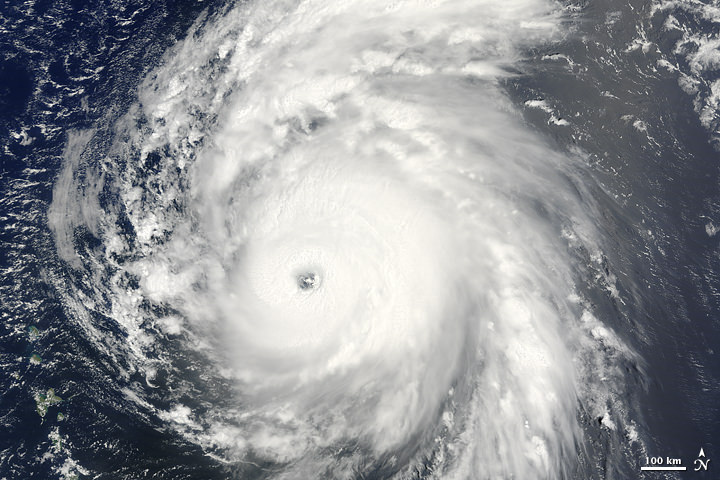This just in — the NASA/NOAA satellite GOES-14 has just released video taken on August 20 (that’s today!) of Hurricane Bill, the first hurricane of the season. This spectacular video is a collection of a few quick movies put together by the GOES-14 team and includes an impressive zoom-out, showing how big the hurricane is, relative to the hemisphere. Yes, Bill is large, with sustained winds of 217 kph (135 mph), making it a powerful Category 4 storm. The winds extend outward up to 80 miles from the center. Bill stretches more than 1,200 kilometers (746 miles) across, and the storm’s partially cloud-filled eye is nearly 50 kilometers (31 miles) wide.
See an image below of Bill from NASA’s MODIS satellite, taken on August 19, 2009.
[/caption]
As of August 20 at 5 pm EDT, Hurricane Bill was located 790 miles SSE of Bermuda, while continuing to move quickly off to the northwest. Bill should begin turning in a more northerly direction by later Friday.
Based on all available forecast data at this time, it appears that Bill will track east of the Eastern U.S. Coast over the next few days.
You can follow a tracker on Weather.com to find out where Hurricane Bill is currently located.


Just my luck, the first named hurricane of the season, and it’s my namesake!
You’re lucky. Tropical Storm Kevin in 2003 fizzled as soon as it began.
1997, Hurricane Rick hit Mexico as a Cat2, just after Hurricane Pauline hit, “one of the deadliest Eastern Pacific storms in recorded history”. Yeah… if it makes you feel better mine was more like a dog cleaning up table scraps… humiliating.
I’m not one to brag or anything, but mine was a category 5 that killed 2000 people in 1979. It even caused flooding and power outages in New York!
http://en.wikipedia.org/wiki/Hurricane_David
@ecilpl:
Show off.
Honestly, David – stop tooting your own horn.
So many people are not aware the Eastern Pacific or the west of Southern Mexico and west of Central America has twice the number of tropical storms than the Atlantic Ocean, or the 2nd most busy areas for tropical storms in the world.. Happily, most of these storms heads westward toward Hawaii but dies out far from Hawaii, at random times, some of the tropical storms or hurricanes turns east and strikes a city in western Mexico kill people and causing havoc with the communities. . Generally, the cold waters of the California current spares the SW US from a full blown storm as tropical storms hates cold waters. El Nino years can change the water temperatures in Southern California, a reported short hurricane struck San Diego,CA in 1860 causing death and destruction, while in 1939 a tropical storm went as far north as Long Beach killing `50, while in 1992 another weaker El Nino episode cause a powerful F4 hurricane INIKI hit one of the Hawaiian Islands killing people and cause +$2B. To many climatologist, the 1990s’ were known as the El Nino decade.
2 of the most unusual storms hit, 1994 Hurricane John set a world record by lasting 31 days, started from West of Central America, hit 155 knots for a few days 400 miles (640km) south of the Hawaii and scaring everyone!!. It traveling past the DATE line becoming Typhoon John for a day or 2 then headed East becoming Hurricane John again, the distance traveled before croaking out was 8100 miles 13000km.
In 1997 Hurricane Linda terrorized Baja California and was forcasted to head to California but deciided to head west, The lowest barometric pressure was 902mb and winds were sustained between 180-195mph or 290-310km/hr with gust to 218mph or 351km/h, Because this beast was over open water, the winds stayed super high for days!!!
It is unusual there is less tropical storms in
the Eastern Pacific this decade, but tropical storms runs in cycles.
Its funny to me but every time i look at a Hurracane, I cant help but think that it reminds me of the formation of a galaxy.